this info was provided by RealTime Labs...
Mold: Stachybotrys chartarum
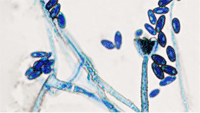
Stachybotrys chartarum is the well-known "black mold" seen in many water damaged buildings. Stachybotrys grows well on all sorts of wet building materials with high cellulose content, for example, water-damaged gypsum board, ceiling tiles, wood fiber boards, and even dust-lined air conditioning ducts. While it is one of the EPA ERMI panel mold species, it is frequently not detected due to the large size and weight of the spores, and the damp environment required for Stachybotrys growth. The spores are not easily airborne and disseminated throughout the house. In the RealTime Labs environmental testing, the presence of the macrocyclic trichothecene mycotoxins (produced by Stachybotrys) are found 3X as often as spores of the mold.
Mycotoxins: Stachybotrys has been demonstrated to produce a number of Macrocyclic Trichothecene mycotoxins including Satratoxin G, Satratoxin H, Isosatratoxin F, Roridin A, Roridin E, Roridin H, Roridin L-2, Verrucarin A and Verrucarin J. These are among the most toxic of all mycotoxins. Since these are low Molecular Weight molecules, they can easily float around in the air on particles such as fungal debris or dust particles, and be inhaled by inhabitants of the dwelling. It has also been demonstrated in animal models that other than direct injection into the brain, inhalation of Trichothecenes is the most lethal mode of exposure. These mycotoxins have been demonstrated to be present in the indoor air of Stachybotrys infested buildings. Given the frequency of infestation by Stachybotrys and the toxicity of its mycotoxins, it is critical that any mycotoxin testing include testing for the macrocyclic trichothecenes, and not just simple trichothecenes such as T-2, which is produced by Fusarium, not generally considered to be an indoor toxic mold.
Health Effects: Macrocyclic trichothecenes are known to be highly cytotoxic and are potent inhibitors of protein synthesis. This can affect almost all cells in the body. The health effects of trichothecenes are known, as cancer patients were administered a trichothecene called anguidine in a 1978 and 1979 clinical study in the hope that its inhibition of protein synthesis would selectively kill the faster multiplying cancer cells. The study was terminated due to the severe symptoms/side effects of anguidine which included: nausea, vomiting, diarrhea, burning erythema, ataxia, chills, fever, hypotension, hair loss and confusion. These side effects were very similar to the symptoms described by individuals living or working inside Stachybotrys infested homes and buildings.
Mold: Aspergillus flavus
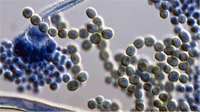 Mycotoxin; A. flavus produces aflatoxins, the most toxic and potent hepato-carcinogenic natural compounds ever characterized. There are four major Aflatoxins: B1, B2, G1, G2. Aflatoxin B1 is the most potent carcinogen and is the major mycotoxin produced by A. flavus. Aflatoxin's reputation as a potent toxin may explain why it has been adopted for use in bioterrorism. There is substantial evidence that Iraq stockpiled aflatoxin to be delivered in missiles. Epidemiological studies implicate aflatoxins in food as the causative agent for liver cancer. There is no other natural product for which the data on human carcinogenicity are so compelling. The International Agency for Research on Cancer has classified aflatoxin B1 as a group I carcinogen.
Mycotoxin; A. flavus produces aflatoxins, the most toxic and potent hepato-carcinogenic natural compounds ever characterized. There are four major Aflatoxins: B1, B2, G1, G2. Aflatoxin B1 is the most potent carcinogen and is the major mycotoxin produced by A. flavus. Aflatoxin's reputation as a potent toxin may explain why it has been adopted for use in bioterrorism. There is substantial evidence that Iraq stockpiled aflatoxin to be delivered in missiles. Epidemiological studies implicate aflatoxins in food as the causative agent for liver cancer. There is no other natural product for which the data on human carcinogenicity are so compelling. The International Agency for Research on Cancer has classified aflatoxin B1 as a group I carcinogen.
Health Effects: In addition to the carcinogenic effect of aflatoxins, A. flavus is the second leading cause of invasive aspergillosis in immunocompromised patients. Particularly common clinical syndromes associated with A. flavus include: chronic granulomatous sinusitis, keratitis, cutaneous aspergillosis, wound infections and osteomyelitis following trauma and inoculation.
Mold: Aspergillus ochraceus
 Mycotoxin: Ochratoxin A
Mycotoxin: Ochratoxin A
Health Effects: Ochratoxin A has been shown to interfere with cellular physiology in multiple ways. It inhibits synthesis of phenylalanine t-RNA complex, inhibits mitochondrial ATP production, and stimulates lipid peroxidation. It has been demonstrated to be Nephrotoxic, Hepatotoxic, and Carcinogenic and is a potent teratogen and immune-suppressant. It has also been associated with urinary tract infections and bladder cancers. Ochratoxin has been detected in blood and other animal tissues and in milk, including human milk.
Mold: Aspergillus niger
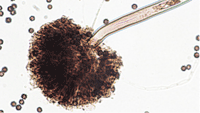 Mycotoxin: Ochratoxin A
Mycotoxin: Ochratoxin A
Health Effects: Ochratoxin A has been shown to interfere with cellular physiology in multiple ways. It inhibits synthesis of phenylalanine t-RNA complex, inhibits mitochondrial ATP production, and stimulates lipid peroxidation. It has been demonstrated to be Nephrotoxic, Hepatotoxic, and Carcinogenic and is a potent teratogen and immune-suppressant. It has also been associated with urinary tract infections and bladder cancers. Ochratoxin has been detected in blood and other animal tissues and in milk, including human milk.
Mold: Aspergillus versicolor
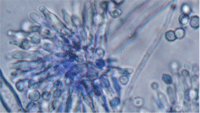 A. versicolor is one of the most frequently found molds in water damaged buildings. Spores of A. Versicolor are detected and quantified in the ERMI (Environmental Relative Moldiness Index) test by Real Time PCR
A. versicolor is one of the most frequently found molds in water damaged buildings. Spores of A. Versicolor are detected and quantified in the ERMI (Environmental Relative Moldiness Index) test by Real Time PCR
Mycotoxin: Sterigmatocystin. Sterigmatocystin is a potentially carcinogenic and hepatotoxic mycotoxin, similar to Aflatoxins but not as toxic. Sterigmatocystin is a precursor in the biosynthesis of Aflatoxins. It has been detected in many damp, mold contaminated building materials and in carpet dust from moldy indoor environments.
Health Effects: Sterigmatocystin is classified as a class 2B carcinogen (possibly carcinogenic to humans). It has been demonstrated to cause pulmonary adenocarcinomas in mice and liver tumors in rats. It is primarily toxic to the liver and kidneys.
Mold: Aspergillus fumigatus
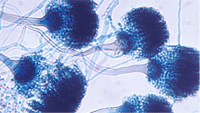
A. fumigatus is frequently found in homes and buildings. It is considered to be an opportunistic pathogen, meaning it rarely infects healthy individuals, but is the leading cause of invasive aspergillosis (IA) in immunocompromised individuals such as cancer, HIV or transplant patients. IA is the leading cause of death in these patients, with a mortality rate of 30% to 80%. Patients are infected by breathing in the spores of the fungi.
Mycotoxin: Gliotoxin
Heath Effects: Gliotoxin has been shown to suppress the immune system, making the host more susceptible to the infections by A. fumigatus or other opportunistic pathogens. Gliotoxin was demonstrated to suppress T-cell response, inhibit antigen-presenting cell function and induce the death of monocytes.
Mold: Chaetomium globosum
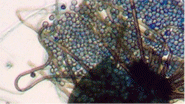 C. globosum is a common indoor fungal contaminant of water damaged homes or buildings. It is found on wet drywall, wall-paper, carpets, window frames and baseboards. Like Stachybotrys, C. globosum spores are relatively large and due to their mode of release are not as easily airborne as other molds. Hence, the spore concentration may not be indicative of the severity of the mold contamination, or its production of Chaetoglobosins, the mycotoxin produced by C. globosum. Chaetomium requires chronic moisture conditions to grow, so its presence is indicative of a serious ongoing or previous moisture problem.
C. globosum is a common indoor fungal contaminant of water damaged homes or buildings. It is found on wet drywall, wall-paper, carpets, window frames and baseboards. Like Stachybotrys, C. globosum spores are relatively large and due to their mode of release are not as easily airborne as other molds. Hence, the spore concentration may not be indicative of the severity of the mold contamination, or its production of Chaetoglobosins, the mycotoxin produced by C. globosum. Chaetomium requires chronic moisture conditions to grow, so its presence is indicative of a serious ongoing or previous moisture problem.
Mycotoxin: Chaetoglobosin A, C
Health Effects: Chaetoglobosins are lethal to mammalian cells due to binding to actin and inhibition of cell division and movement. In one study, injection of Chaetoglobosin A in rodents was fatal at relatively low doses.
Mold: Penicillium verrucosum
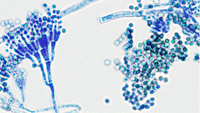 Mycotoxin: Ochratoxin A
Mycotoxin: Ochratoxin A
Health Effects: Ochratoxin A has been shown to interfere with cellular physiology in multiple ways. It inhibits synthesis of phenylalanine t-RNA complex, inhibits mitochondrial ATP production, and stimulates lipid peroxidation. It has been demonstrated to be Nephrotoxic, Hepatotoxic, and Carcinogenic and is a potent teratogen and immune-suppressant. It has also been associated with urinary tract infections and bladder cancers. Ochratoxin has been detected in blood and other animal tissues and in milk, including human milk.
Mold: Fusarium sp.
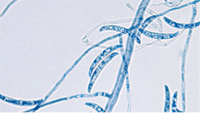 More than 50 species of Fusarium have been identified. Most are plant pathogens and can infect crops such as wheat, barley, oats and other feedstuff, where they can produce mycotoxins. Testing of food and feed for mycotoxins produced by fusarium is mandated by regulatory agencies and maximum allowable limits have been set. The most common species causing human infections is Fusarium solani. This is rarely found in water damaged buildings and is not currently part of the EPA ERMI test of molds found in damp homes.
More than 50 species of Fusarium have been identified. Most are plant pathogens and can infect crops such as wheat, barley, oats and other feedstuff, where they can produce mycotoxins. Testing of food and feed for mycotoxins produced by fusarium is mandated by regulatory agencies and maximum allowable limits have been set. The most common species causing human infections is Fusarium solani. This is rarely found in water damaged buildings and is not currently part of the EPA ERMI test of molds found in damp homes.
Mycotoxin: Simple Trichothecenes (T-2, Deoxynivalenol (DON)), Fumonisin, Zearaleone
Health Effects: Approximately 12 species of Fusarium have been shown to produce infections in humans, including F. solani, the most frequently detected species (>50%). Fusarium can cause superficial infections such as keratitis or onychomycosis in health individuals and disseminated infections in immunocompromised patients. T-2 is the most toxic of the Fusarium Mycotoxins. Most of the knowledge of its effects come from studies on ingestion of T-2 contaminated food. It is causes depression of the immune system, nausea and vomiting. It has been shown in experimental animals that trichothecenes are 40 times more toxic when inhaled than when ingested. T-2 is listed as a chemical warfare agent and has believed to have been used in combat. Fumonisin B1 has been linked to a higher incidence of esophageal cancer in regions consuming maize with higher concentrations of this mycotoxin.